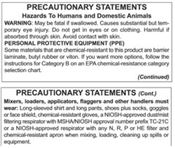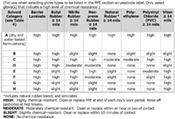If The Glove Doesn’t Fit (The Job!), You Must Quit
DR. RIC BESSIN
LEXINGTON, KY.
Many pesticides require the use of gloves during one or more pesticide-handling or early-entry operations in order to reduce pesticide exposure. Often, it is our hands that are most likely to become contaminated when handling pesticides. But different pesticides may require very different categories of gloves made of different materials. This is due to the diverse types of solvents used to formulate pesticides. Specific glove types that meet requirements for handler personal protective equipment (PPE) are always listed on respective pesticide labels. A specific type of chemical-resistant glove may protect from some, but not all, solvent types used in various pesticide formulations. Pesticides handlers must carefully read the PPE section of the label to determine which glove type will provide protection from the pesticides they will be using.
The EPA determines the type of chemical-resistant glove required based on the solvents in the pesticide. Because some solvents can penetrate through some types of chemical-resistant gloves, label requirements vary among pesticide labels. The EPA groups pesticides into 8 different categories (A-H), and rates the chemical resistance of various gloves materials to these solvents. The categories of chemical-resistant gloves listed on labels include barrier laminate, butyl rubber, nitrile rubber, neoprene rubber, natural rubber, polyethylene, polyvinyl chloride, and viton.
Pesticide applicators should review the PPE requirements for all of the pesticides they plan on using to identify their glove requirements for those products. Some products may list several alternative types of gloves, while others may be much more specific. Even though gloves protect your hands from pesticide exposure, it is always a good practice to wash your hands after removing your gloves. ∆
DR. RIC BESSIN: Extension Specialist, University of Kentucky

Figure 1. Example PPE glove requirements from the Precautionary Statements portion of a pesticide label.

Figure 2. EPA Chemical-Resistant Category Selection Chart
Source: EPA Label Review Manual